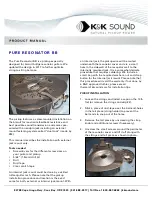
Chapter 15
Using Cable and Antenna Analyzer
532
JD700B Series User’s Guide
Measurement example
Figure 323 Reflection measurement in return loss scale
NOTE
You can use the
LIMIT
hot key to analyze your measurements with the user-definable
limit and Pass/Fail indication. See “Setting limit for cable and antenna analyzer” on page
544 for more information.
NOTE
You can go to
MEASURE SETUP > Zoom
to view your measurements in detail with the
user-definable zoom zones. See “Setting zoom zones” on page 543 for more information.
Performing DTF measurements
The Distance-To-Fault (DTF) measurement can be used to accurately identify fault locations in the cell-site
transmission (cable and feed line) system, indicating signal discontinuities in VSWR or return loss over
distance in meter or foot. This measurement precisely pinpoints the location of such things as damaged or
degraded antennas, connectors, amplifiers, filters, and duplexers.
Making a measurement
Procedure
1
Make a proper cable connection as described in “Connecting a cable for reflection, DTF, 1-port
phase, and Smith Chart measurements” on page 528.
2
Press the
MEASURE SETUP
hot key.
3
Press the
Data Points
soft key to change the resolution of your measurement, and then select
the data point option:
126
,
251
,
501
,
1001
, and
2001
. Changing the data point does not affect
current calibration.
NOTE
The larger number you choose, the higher resolution you get and the longer the
instrument takes to sweep and display results. Selecting the data point larger than what
you need for a measurement will result in unnecessarily long sweep time. It is
recommended that you select high resolution data points only for an instance of
measuring wide frequency bands or requiring precise measurement data.
















































